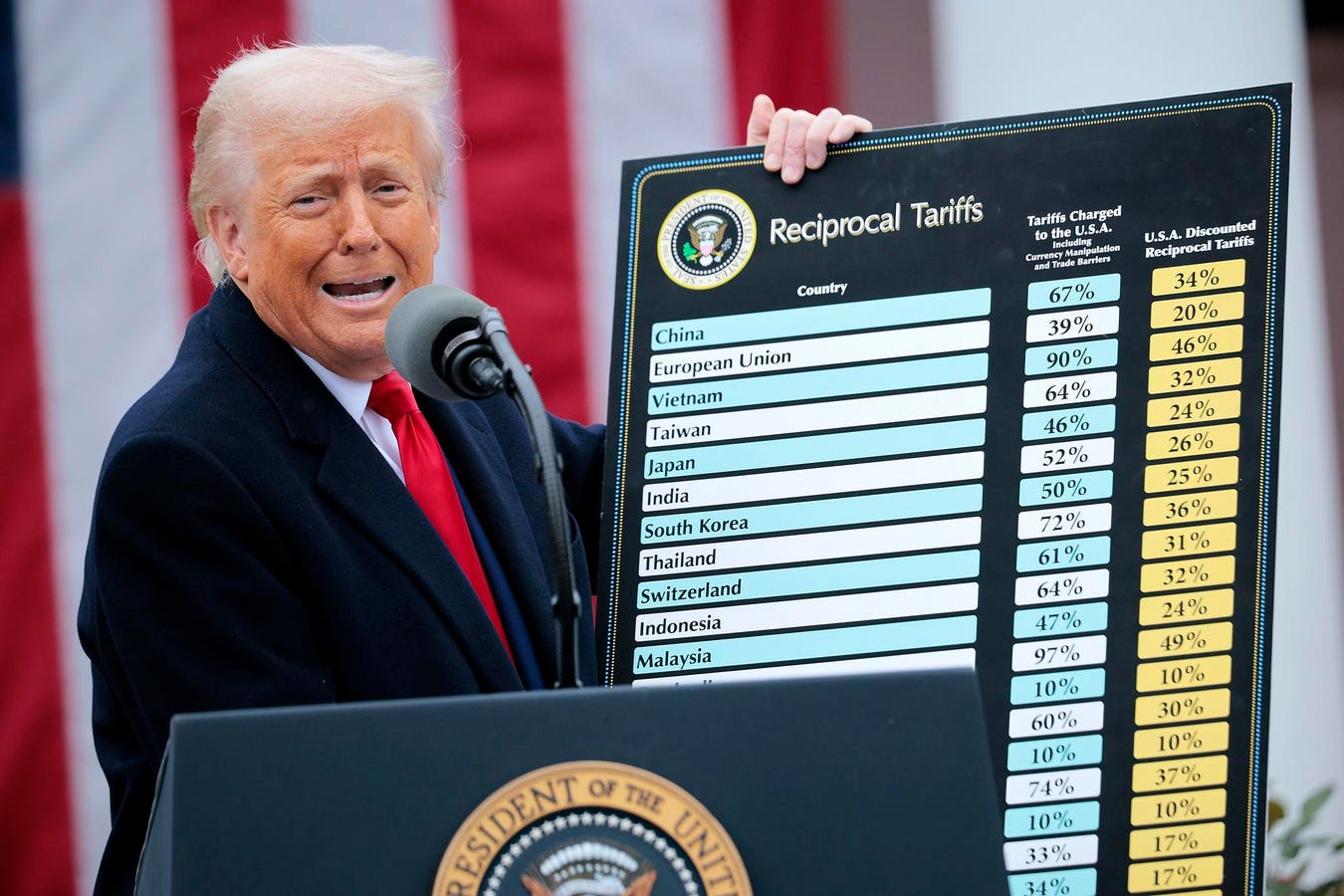WASHINGTON, DC – APRIL 02: U.S. President Donald Trump holds up a chart while speaking during a … More
If appropriately implemented, new tariffs could reduce “sludge.” Sludge is a term the podcast “Freakonomics” applies to unnecessary complexity that makes life more difficult and stressful. Sludge raises costs and distorts the efficient operation of an economy. No area of any economy may have more sludge than tariff classification.
Specific versus Ad Valorem Tariffs
A specific tariff involves a fixed fee levied on one unit of an imported good. This tariff varies according to the type of goods imported. For example, a country could levy a $15 tariff on each imported shirt but a $250 tariff on every smartphone.
The phrase “ad valorem” is Latin for “according to value.” This type of tariff is levied on a good based on a percentage of that good’s value. An example of an ad valorem tariff would be a 10% tariff levied by the European Union on U.S. automobiles that come complete with internal combustion engines. Thus, for a $50,000 car, the tariff would be $5,000. In contrast, the US has levied a tariff of 2.5% for the same goods from EU entering the US.
A compound tax is a combination of both specific and ad valorem tariffs. In the case of China, the Trump administration is proposing very high ad valorem tariffs imposed on top of the existing specific tariffs.
However, if ad valorem tariffs are going to be significant, why even have specific tariffs? This is an opportunity to reduce trade sludge.
The Harmonized System
Specific tariffs are based on the international Harmonized System. This is a global system of nomenclature that is used to describe most world trade in goods. This is maintained by the World Customs Organization. Virtually all countries base their tariff schedules on the WCO’s Harmonized System. HS codes are six-digit codes.
The Harmonized Tariff Schedule of the United States is based on the harmonized system. This is the primary resource for determining customs duties classifications for goods imported into the United States. The Harmonized Tariff Schedule classifies a good based on its name, use, and/or the material used in its construction and assigns it a ten-digit classification code number. The HS code is a subset of the U.S.’s tariff schedule – the first six digits are the same.
There are over 17,000 unique classification code numbers in the U.S. But worse than the sheer number of classification codes is the complexity.
Using the right HS code allows companies to pay the correct tariffs. Paying the right tariffs is necessary to avoid hefty government fines as well as to protect brand reputation. The problem is an incredible gap between how products are described commercially and how they are expressed in the national customs tariff schedules.
To say that HS codes are non-intuitive would be a massive understatement. What a regular person would describe as “baby food” in HS speak is known as a “homogenized composite food preparation;” a “hair blower” is an “electrothermic hairdressing apparatus;” before you can classify “rayon,” you have to know whether this is an “artificial” or a “synthetic” fiber; and if you were classifying an automotive part, like a car alarm, you might think you would go to the section of the HS code focused on automobiles, but no – this is an electronic signaling device.
This has resulted in historic error rates of up to 30%.
Artificial Intelligence and Trade Classification
Global trade management systems leveraging AI do reduce classification errors. How much is unclear. Further, the application of AI to GTM solutions comes with challenges.
First, the AI’s output is only as good as the data input. Data cleansing can help, but often, improving data quality will require supply chain partners to get involved. Freight forwarders may fear that collaboration could lead them to become an unnecessary middleman.
The bigger the model, the better the AI model. A global trade management solution has components for electronically messaging trade authorities with documents on the number of imported goods and their classification, process workflow, and an updated database of how the tariffs should be applied to specific products. The best databases for trade content are built using a public cloud architecture. In other words, the database is shared by all the customers using a particular GTM solution. This allows for much, much larger AI models. However, public clouds do significantly increase the need for strong cybersecurity.
AI can also have a “black box” problem where users don’t understand how the answer was generated. If a trade professional does not understand the logic, they are unlikely to use it.
Further, if a shipper does get audited, it is important that the GTM system provides an audit trail that shows how goods were classified with a logic tree that explains why the goods were classified that way.
In many jurisdictions, this audit trail demonstrates “good faith” and means that even if a declared good was misclassified, the company would be given credit for exercising diligence and would thus be likely to avoid the most severe penalties. More likely, they would not be penalized at all. Many shippers, if audited, have no ability to explain why they classified goods as they did. Black box AI has the same problem.
Non-Tariff Barriers
For significant ad valorem tariffs, there is an opportunity for simplification. However, trade classification is not the only contributor to trade sludge.
The White House issued an executive order explaining their rationale for reciprocal tariffs and why trade disparities are a national emergency. They pointed to non-tariff barriers that make it harder for U.S. firms to export goods. Non-tariff barriers include import barriers driven by licensing restrictions, unnecessarily restrictive quality standards on goods or technical regulations, sanitary measures that restrict trade without furthering safety objectives, and several other categories of restrictions. One goal of the tariffs is to negotiate reductions in these non-tariff barriers.








